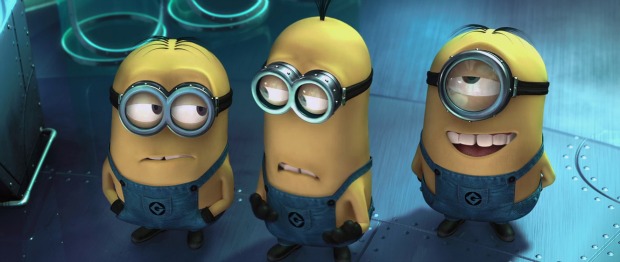Despicable Me
After this, we may come to see Illumination as credible challengers to the Pixar throne.
Plot summary
When a criminal mastermind uses a trio of orphan girls as pawns for a grand scheme, he finds their love is profoundly changing him for the better.

Despicable Me, the first film from production company Illumination Entertainment, tells the story of Gru, one of the world’s greatest super-villains, and the three orphan girls he adopts as part of his wicked plan to steal the moon. I sat down with the film’s producer, Chris Meledandri (Ice Age, Horton Hears a Who!), to talk about big-hearted villains, miniature minions, and the future of animation.
The original idea for the film apparently came from Meledandri’s sons, who would come away from films more interested in the villain than the hero. Feeling that heroes had become “bland and predictable,” Meledandri went searching for a story of an anti-hero, and found Spanish animator Sergio Pablos and his concept for Despicable Me. Bringing on board animation, design and directing talent from Disney, Pixar, Fox and Universal, they set about making a new sort of hero which both parents and children could enjoy.
Gru, voiced by Steve Carell, is the kind of bad-guy you can really get behind. With his Tim Burton-esque haunted house and Edward Gorey aesthetic, he appears as a classic movie bad-guy, taking great pleasure in little acts of wickedness; the kind of petty things we would love to do on a daily basis if only we had the guts. He wants to be the world’s greatest super-villain to win the approval of his hard-hearted mother (Julie Andrews, playing the anti Mary Poppins). Gru is thwarted in his schemes by the new evil-kid on the block, Vector (Jason Segel), looking like if Apple made super-villains, with his high-tech lasers and guns that shoot piranhas. Together they race to see who can steal the moon first and claim the title of the world’s most wanted.
As part of his scheme, Gru adopts three orphan sisters in order to gain entry to Vector’s house, and through his adoption of the girls we see a different side of the big bad-guy. It’s no surprise how the story ends, but the characters are all so charming, and the scenarios so engaging, that you don’t mind being taken along for the ride.
The real stars of the show, however, are Gru’s minions. Continuing with a tradition he started with Scrat in Ice Age, Meledandi introduces the entirely superfluous and hilarious minions to ease the tension or break up the action. As with Scrat, there’s no real point to them, but you feel like cheering every time they come on screen. They look like the pods inside kinder surprise, are small, mischievous and not very bright. One of the funniest aspects, for me at least, came through Carell’s improvisation during vocal sessions, throwing out mundane names for the minions, such as Jerry, Dave or Tim. Immediately endearing and constantly amusing, they are the characters that will stick with you once you leave the cinema.
Coming after the giddy, Seussian highs of Horton Hears a Who, and the saccharine depths of Ice Age 3, Chris Meledandri’s latest animated caper finds a happy middle ground. The comedy is surreal and at times surprisingly dark. There are laugh out loud moments for the kids as well as deliciously mean visual gags for the parents (keep your eye out for the Bank Of Evil for a guaranteed belly laugh). The emotional heart of the tale may not be as bleak as what’s going on over at Pixar, but it is sad and sweet, and at times beautifully subtly written. The animation had a certain Edward Gorey sensibility, with a touch of Tex Avery madness thrown in for good measure.
While Pixar still reign supreme, Meledandri and his team have put together a film which will definitely put Illumination on the map as the underdogs to watch. Upon asking him where he sees animation, and his company in particular, going in the future, Meledandri stressed a strong focus on the creative talent within the company, saying that “what excites me is the artists themselves and not the technological advances, [in particular] the integration of different artistic voices from different cultures into our creative process.” In an industry seemingly more and more obsessed with gimmick over quality, it is good to hear a producer dedicated to putting out an artistically credible and entertaining product. With Hop and The Lorax scheduled for the next two years, we may come to see Illumination as credible challengers to the Pixar throne.












COMMENTS